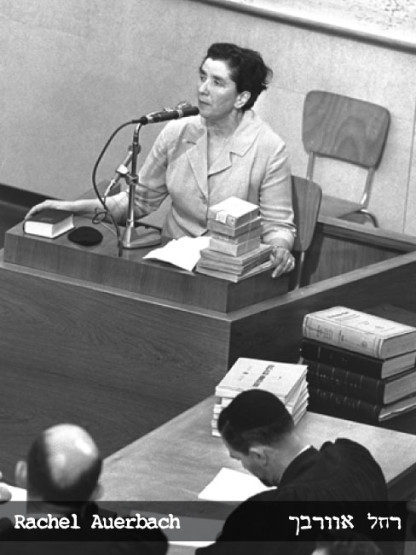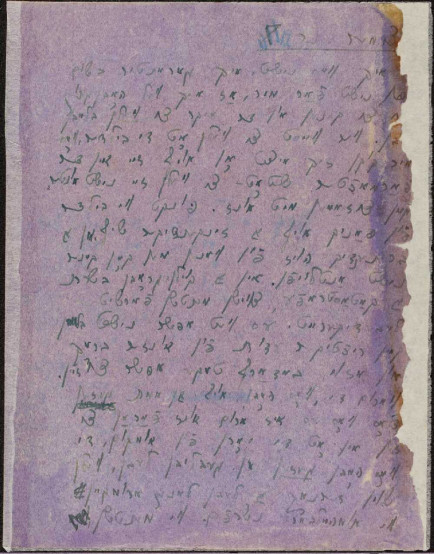Will of Survival, Obligation to Witness… Rachela Auerbach and the Women of Oneg Shabbath in the Warsaw Ghetto - Instytut Pileckiego
28.08.2024 () 18:00
Will of Survival, Obligation to Witness… Rachela Auerbach and the Women of Oneg Shabbath in the Warsaw Ghetto
Lecture will take place as part of the event series accompanying our exhibition "Doppelt Frei"

„Will of Survival, Obligation to Witness… Rachela Auerbach and the Women of Oneg Shabbath in the Warsaw Ghetto“
Lecture by Szymon Pietrzykowski (Jewish Historical Institute, Warsaw Poland)
28.08, 18.00 | Pariser Platz 4A, 10117 Berlin | Registration: https://forms.gle/zNVXjHr4EUtSQFrq5

There were approximately 70-80 people involved in various activities of the so-called Oneg Shabbat group (“The joy of Saturday” in Hebrew) which created the Underground Archive of the Warsaw Ghetto. We know 35 people by name and last name, including its founder, Emanuel Ringelblum (1900-1944). Among them were seven women: Rachela Auerbach (1903-1976), Gustawa Jarecka (1908-1943), Henryka Łazowertówna (1909-1942), Salomea Ostrowska, Gela Seksztajn (1907-1943), Cecylia Słapakowa (1900-1943), Bluma Wasser (1912-1990).

All of them came from similar environment – more or less assimilated Jewish intelligentsia. They were well-educated humanists and tried to succeed (with greater and lesser effect) in prewar Warsaw intellectual or artistic environment. Only Rachela Auerbach and Bluma Wasser survived the Holocaust - together with another survivor, Hersz Wasser (Bluma’s husband, secretary of Oneg Shabbath and Ringelblum’s right hand man), they played a crucial role in finding valuable documents buried underground, hidden in ten metal boxes and two milk cans.

Women of the Oneg Shabbath played varied and important role in documenting the ghetto’s daily life and alarming the world about the ongoing Holocaust. Rachela Auerbach managed the people’s kitchen at Leszno Street 40 and kept a dairy in which she described her experiences, including that responsible managerial function. Later she talked with an escapee from Treblinka camp, Jakub Krzepicki, wrote down and redacted his testimony. Gustawa Jarecka, fluent in German, worked for the Jewish Council (Judenrat), copied and then secretly passed multiple announcements made by the German occupation authorities. She wrote a shocking relation about the Great Liquidation Action (Grossaktion) of the Warsaw Ghetto (from July 22 till September 21, 1942, about 300,000 people were deported and killed in Treblinka) entitled “The Last Stage of Resettlement is Death”. Salomea Ostrowska, about whom we know very little, worked in quarantine facility, where the refugees and deportees were temporarily isolated before entering the ghetto. She also conducted several interviews with prisoners of the labor camp in Pomiechówek near Warsaw. Gela Seksztajn was a painter before the war, in the ghetto she devoted herself entirely to teaching and taking care of her family, about 300 of her sketches and watercolors have survived, buried in one of the metal boxes.

Before the war and at the beginning of the occupation Cecylia Słapakowa ran a literary salon. In the ghetto she conducted research about the situation of Jewish women based on conversations with a dozen or so interlocutors - females who had to radically change their lives, adapt to the brutal ghetto circumstances, and take care for their own survival and the survival of their loved ones. Bluma Wasser supported her husband in dealing with the refugees and deportees, they both interviewed them - most of their testimonies were transcribed by her. We also should remember about the other women mentioned in the Underground Archive (and other sources) - artists, teachers, prisoners, liaison officers/fighters.
As demonstrated by Słapakowa’s study it was easier for women to find their way in the ghetto, they often became heads of families, main or sole breadwinners - in the absence of their husbands or partners, who were often deported to camps, whose health was failing (physically and mentally), and therefore were unable to cope with the radical deterioration of living conditions and the omnipresent death. Without women there would be no secret teaching or Jewish resistance.

They demonstrated the strongest will of survival. As stated by Rachela Auerbach, with each surviving Jewish life the memory of a world that ceased to exist has been preserved, hence the obligation to bear witness. This truth is well reflected in Rachela’s post-war life – her efforts to save the Underground Archive and later in Israel, where she prepared witnesses for the Eichmann trial (1961) and came up with a methodology for conducting interviews with the Survivors at Yad Vashem.
Szymon Pietrzykowski – historian, researcher and educator specializing in Jewish history, with particular emphasis on the Provinz Posen / Warthegau / Wielkopolska (Greater Poland) region; employee in Education Department at Jewish Historical Institute in Warsaw; creator of “Wielkopolski Sztetl” (Greater Poland’s Shtetl) – Polish-language website on Facebook (https://www.facebook.com/WielkopolskiSztetl).